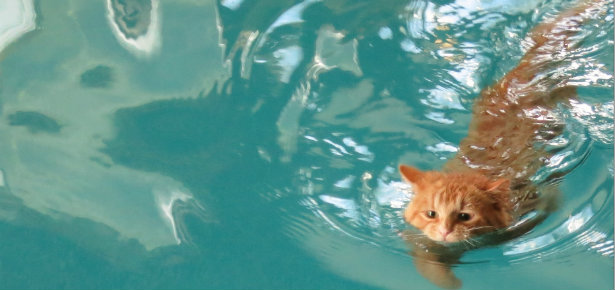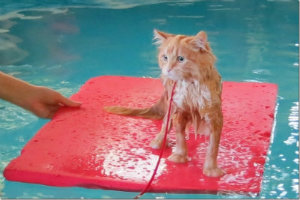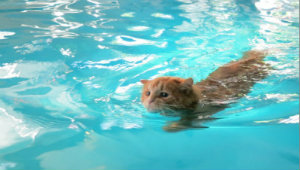

Feline Hydrotherapy
Swimming for feline health
 Is it fair to a cat to swim a cat? Is it humane? Common knowledge tells us that cats usually undergo a high level of stress if they fall into or are placed in water. Anyone who has bathed their cat knows the struggle that will ensue. They can swim to get out but psychologically they are in “flight” or in “fight” and their stress levels may be through the roof.
Is it fair to a cat to swim a cat? Is it humane? Common knowledge tells us that cats usually undergo a high level of stress if they fall into or are placed in water. Anyone who has bathed their cat knows the struggle that will ensue. They can swim to get out but psychologically they are in “flight” or in “fight” and their stress levels may be through the roof.
K9H2O (www.k9h2o.com), an indoor swimming pool for pets, in Abbotsford, British Columbia, is creating a new program to swim cats routinely. The focus is on reducing the entry level of stress for the cat and the owner. It is important the owner work with this process. Training the cat to wear a harness and ride comfortably in a crate in the car are first steps. At the pool, a quiet environment and slow and patient methods are employed. The cat is not rushed and the trainer, in the pool with the cat, focusses on watching body language and positively reinforcing the cat’s calm state.
There are several injuries and birth defects that can be helped with hydrotherapy. Displaced knee caps, hip dysplasia, as well as being hit by a car, attacks from other animals and abuse can all result in skeletal injuries. These types of problems can inhibit normal function that can be eased by hydroptherapy.
“Aqua therapy is proven mode of recovery for dogs, horses, and humans and should be made available to cats as well”, states Kendall De Menech, owner of K9H2O.
“There will always be some stress, that is for sure. My goal is to perfect a method to swim a cat whereby they do not feel the need to go to flight or fight”.

Cats take longer to accept the lessons involved in swimming and their attention span is shorter than dogs. So, owners must first acknowledge the need for their cat to be in the aqua therapy program (eg: spinal injury, weight loss, knee surgery) and be prepared to commit to numerous swims to achieve their cat’s health goals. Referral and communication with the primary veterinarian is beneficial.
For more information on this exciting new program contact Kendall at 1.604.864.2284 or k9h2o@shaw.ca.
Join the newsletter and never miss out on cat content again!
"*" indicates required fields
By clicking the arrow, you agree to our web Terms of Use and Privacy & Cookie Policy. Easy unsubscribe links are provided in every email.










